Outforia Quicktake: Key Takeaways
- Opals are mineraloid stones that can be either precious or ordinary based on silica and water composition.
- Precious opals have a “play of color” effect, making them desirable as gemstones.
- There are four main types of natural opal: black or dark opal, white or light opal, boulder opal, and matrix opal.
- Geographically, natural opals are found in Australia, Mexico, North and South America, Africa, and Indonesia.
- There are 25 distinct subtypes of opals with unique characteristics based on region.
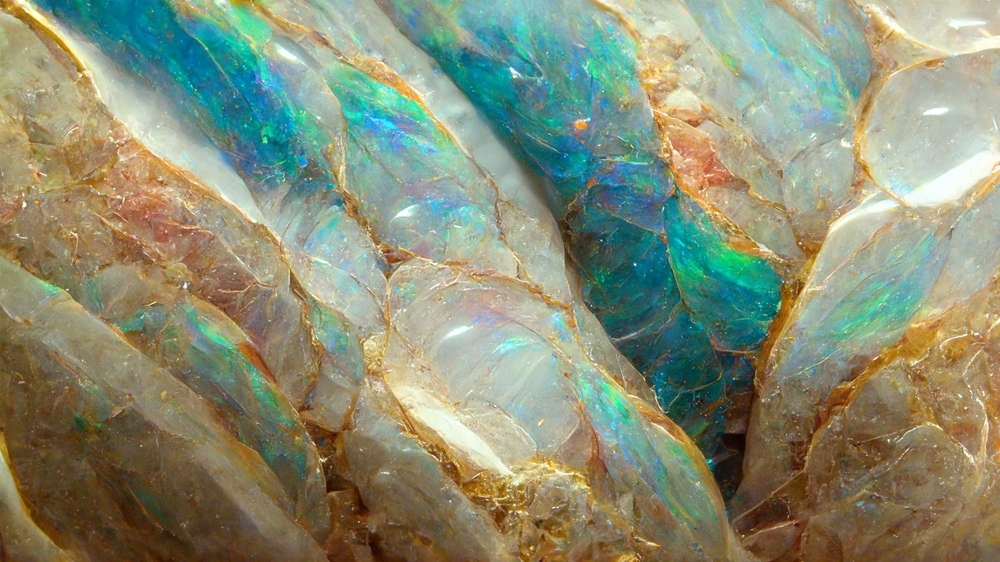
First off, there are two types of opals we need to talk about: precious opals and ordinary opals.
Precious opals are beautiful stones. They are made of layers of silica that build up from water deposits over time. This gives them an appealing color, which is why they’re so in demand!
You can find ordinary opals, too. They are formed the same way but don’t have the same “shimmer” as precious opals.
Besides this difference, there exists four main types of opals and 25 distinct subtypes. Curious to know how they’re different from one another? And what exactly makes an opal an opal? We got you all covered below.
What Is An Opal?

Opals are a mineraloid stone that can be either precious or ordinary. A mineraloid is a stone with a non crystalline structure.
To be classed as an opal, a stone must contain water at a ratio of between 3-21% of the total weight of the stone. An opal is a non-crystalline form of silica. As opposed to a diamond, which is crystalline!
Precious Opals are made of a regular three dimensional grid of spheres of silica with water between them.
The opals you see in expensive jewelry are precious opals. They have a “play of color” effect that comes from the way they are formed. This is what makes opal so desirable as a gemstone.
Ordinary opals are still formed from the same silica and water, but the spheres of silica are not in an orderly stack. They are also different sizes.
What is the “Play Of Color” Effect In An Opal?
The way the silica crystals and water are arranged causes two optical properties in an opal. These are called diffraction and interference.
In a regularly stacked precious opal, white light bounces through the watery gaps between the spheres of silica. This diffracts the light, causing it to spread out into a spectrum of colors. Diffracted wavelengths interfering with each other then enhance some colors and cancel out others.
Here’s how diffraction works!
The same thing happens when you shine sunlight through a glass of water, or through a glass prism. Do you remember that from your school days?
How Are Opals Formed?
Opals are formed at a low temperature compared to other forms of silica rock. They are not the same as quartz, for example. Quartz forms under a higher pressure.
Opals are formed by hydrated silica deposits. This means they are built up by hot water that is carrying silica in it. The water must be hot enough to dissolve the silica. This mixture then trickles down into veins and fissures in rocks.
Over time, the layers of silica build up to form opals. This often happens in volcanic regions.
Where Can Opals Be Found?
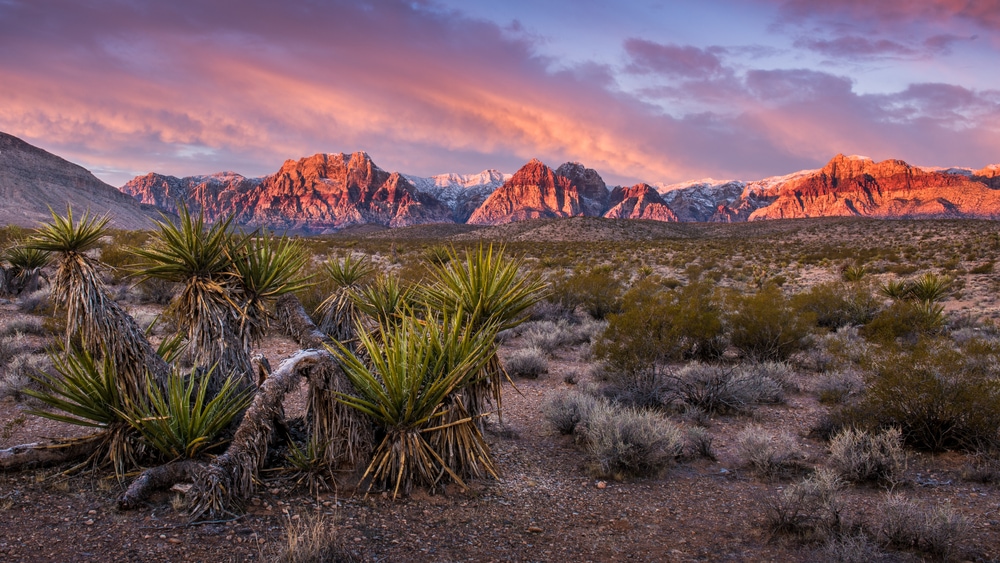
Opals can be found in many kinds of rock. Some of the most common rocks with opals in them are basalt, rhyolite, limonite, sandstone, and marl. Volcanic regions or previously volcanic regions are a good place to look!
Geographically, you can find natural opals in Australia, Mexico, North and South America, Africa, and Indonesia. This becomes more detailed as we focus on specific areas that opals are found in, such as Nevada or Ethiopia.
Australia has the most opal mines and the highest quality of opals in the world.
In the Wollo region of Ethiopia, opals are found embedded in a 60 cm (24 in) band of clay sandwiched between volcanic rocks. Miners dig 20 m (65 ft) into the side of a mountain. The mine is 914 m (3000 ft) from sea level.
Artificial opals are synthetically created by humans. They are manufactured in many places.
You May Also Like: 26+ Types Of Gems: All About These Popular And Rare Jewels
The 4 Main Types Of Opals
There are four main types of natural opal, which can be broken down into more specific sub-types of opal, are:
- Black or dark opal
- White or light opal
- Boulder opal
- Matrix opal
Black Opals
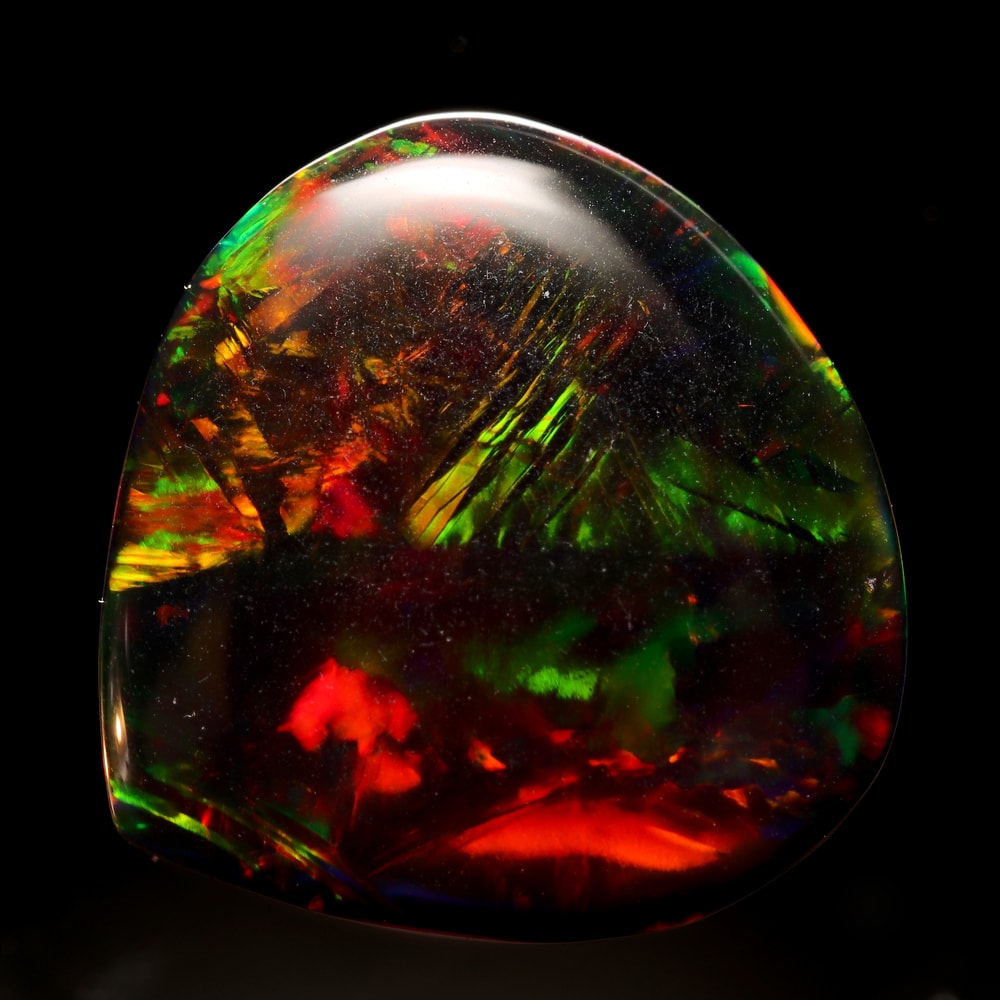
Black Opal is the most expensive and desirable type of opal. It’s not always black but can be dark gray or chocolate brown in color. Precious Black Opal has a brilliant play of color within its dark depths.
The dark color is most often caused by particles of iron and carbon sulfides. These are otherwise known as pyrite and chalcopyrite. Because of the dark color, the diffracted colors stand out better than they would on a white or light opal.
The best quality black opals are found in only a few places in the world! The most expensive black opals come from Australia.
White Opals
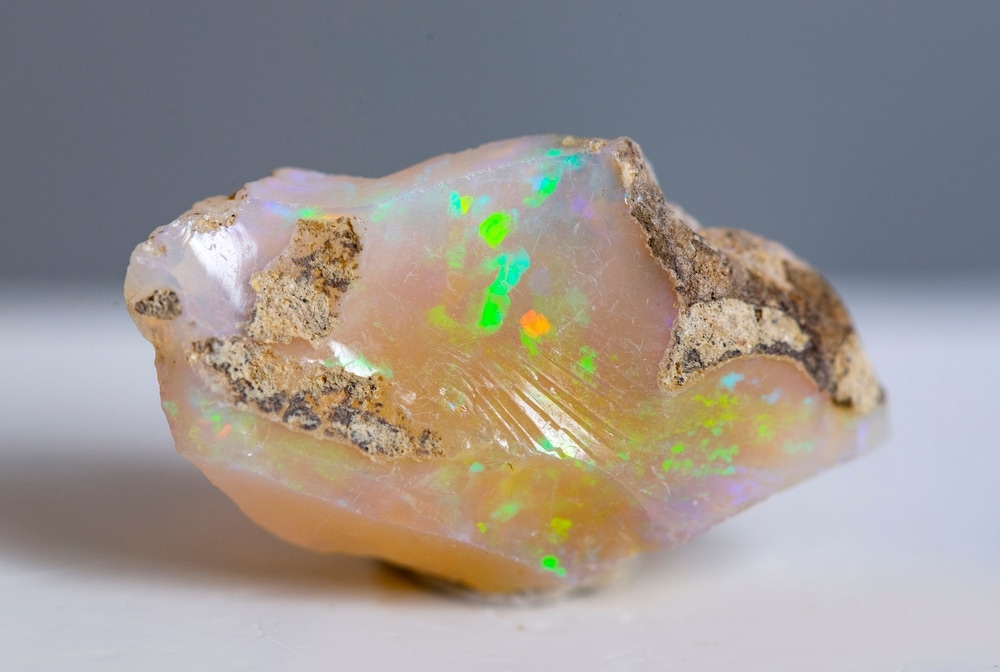
White opals are the most common type of opal. They’re also known as “milky opal.” They’re still really pretty, but the colors don’t stand out as much as they do with black opal. This is why they aren’t as highly prized as black opals. Plus, people always attach value to rarity!
Slovakia and Australia both produce lots of white opals.
Fire Opals
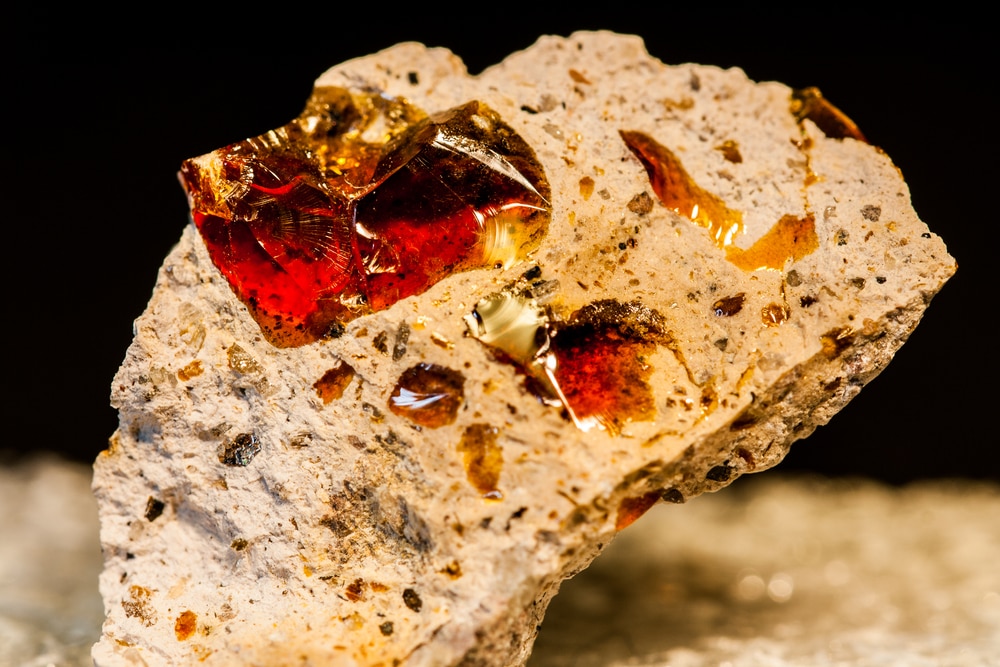
Fire opals are named for the base color being from a range of red, orange, pink, and yellow. This happens due to the presence of iron oxide throughout the stone. They are most often found in Mexico but also in Australia and Ethiopia.
As fire opal is comparatively rare compared to other types of opal, it often commands a high price. The deep passionate hot colors are also what make it popular.
Fire opal represents creativity and passion for many people who use crystals spiritually.
The 25 Types of Opals
Now we can break the types of opals down further by region and characteristics. Each region of the world has opals with their own distinct character.
1. Australian Black Fire Opals

The first ever Australian black opal was discovered in 1877 in the Lightning Ridge area in New South Wales, Australia. These black opals are the most costly on the planet. You can also find opals in the Mintable area. These are more grayish-black.
The world’s most valuable black opal, the Aurorae Australis, was discovered in an Australian seabed in 1938. It was valued at AUD 1M in 2005! It weighed an incredible 180 carats once it had been polished into an oval shape.
Australian black opals are not as absorbent as some other types of opals, like Ethiopian opals. This means they won’t stick to a wet finger or absorb skin oils and change color.
Some famous Australian black opals are called Halley’s Comet, the Black Prince, and the Fire Queen!
2. Ethiopian “Welo” Black Opals

These African opals are also called ‘Welo opals’. Ethiopian opals are relative newcomers on the opal scene. The most important Ethiopian opal discovery was in Wegel Tena in the Wollo area in 2008.
Welo opals tend to be dark brown in body color. They have a high water content.
Some Welo opals are absorbent. These are known as hydrophanes. Due to this, they can sometimes absorb skin oils, cosmetics, and water, and change their color. This means the Ethiopian opal is cheaper than the Australian black opal.
Black Opals from the Stayish mine in the Wollo region have deep gray to black body color.
Want to tell them apart? There’s a great video on how to do that here!
3. Nevada Black Opal
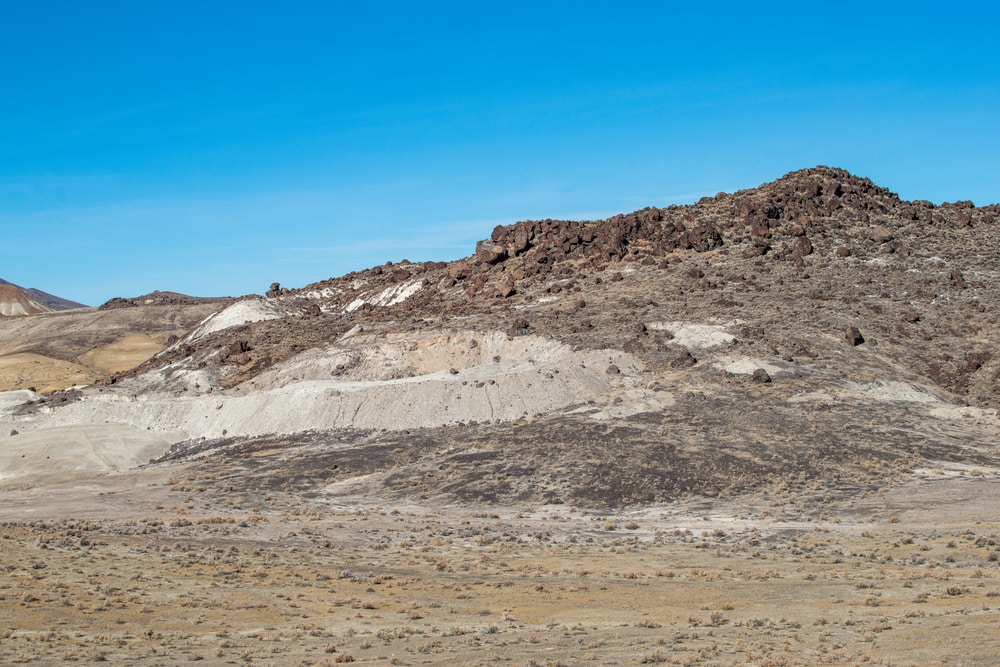
Nevada Black Opals are found in Virgin Valley, in Humboldt County, US. You can tell them apart by their vibrant play of red, violet, green, and blue light. This is known as black fire opal, and it’s found only in Nevada and New South Wales, Australia.
The opal is the official state gemstone of Nevada. You can even mine it yourself if you visit Nevada! You yourself can go opal mining and keep what you find.
Nevada opal is not a good fit for jewelry however, as it’s prone to cracking.
The 1.5 lbs (680 g), 2585 carat Roebling Opal was discovered in Virgin Valley. It was donated to the Smithsonian Museum, so you can see it there!
This is the mess left behind in Virgin Valley from an opal mine.
4. Honduras Black Opal
The Honduras Black Opals have a special deep black color. This is from the bedrock of black volcanic basalt where they are mined. Honduras has some of the oldest opal mines in the world, such as the famous Tablon mine.
Honduran opals have sandstone in them, which means they must be treated in a resin bath before being made into jewelry.
The most famous opal of all time, the “Burning of Troy” was a Honduran opal. It was gifted by Napoleon to his wife Josephine.
Now lost, it was named for the red flashes in its depths. It had a value of 700 carats. Now that’s not such a great thing to lose on a night out!
5. Australian Milk Opal
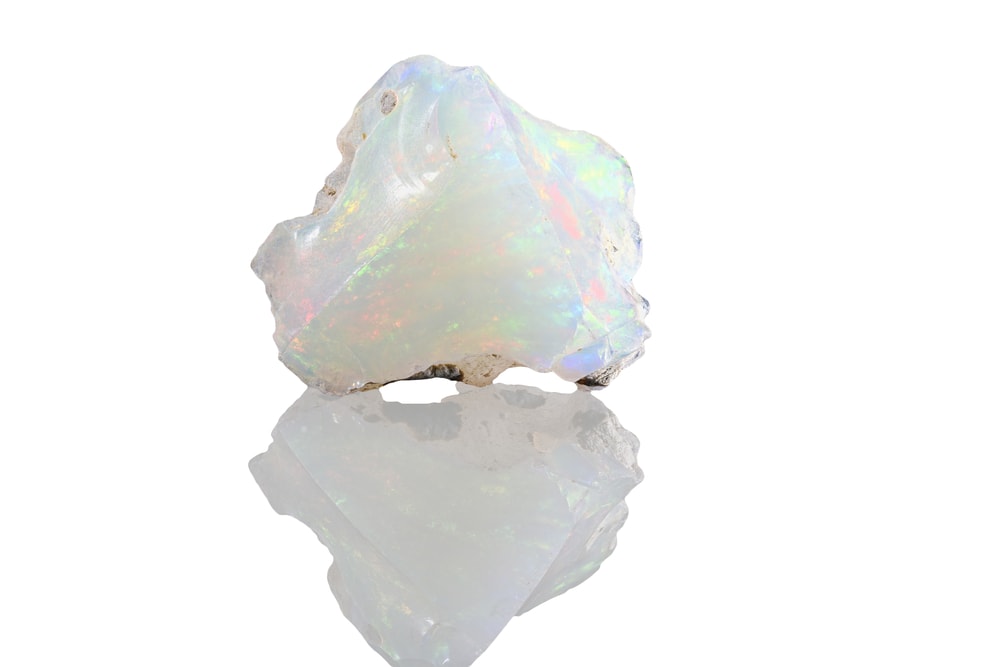
These white opals are mined in South Australia. They’re found in the opal fields of Mintable, Coober Pedy, and Andamooka. They tend to have white potch (opaque bedrock on the back). They can be clear on both sides, too!
Though they aren’t as valuable as Black Opals, they can still fetch up to AUD 200 per carat!
If they are partly translucent, they can be known as White Crystal opals. As when this happens, the colors show up more, and the White Crystal opals have a higher value.
It’s said milk opals came into being after a great inland sea receded from Australia.
6. Boulder Opal
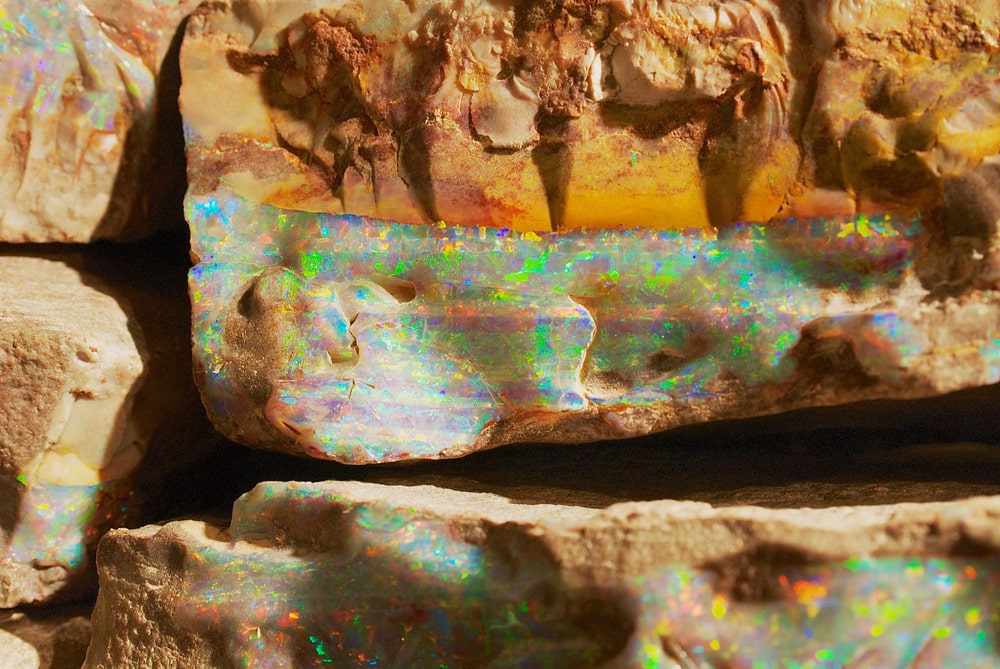
Boulder Opal is characterized by a brown layer of ironstone left on the back of the stone. This is from their origin in iron-rich boulders under the ground.
The reason the layer of ironstone is left on is that the underground veins of opal are so thin, gemstone cutters need to leave some of the ironstone on to get a good sized stone. This gives boulder opals a dark backing which shows off the colors beautifully.
Due to being thin they’re usually cut with a flat or undulating surface, and in a freeform style.
It’s the second most valuable type of opal after Black Opal.
Boulder opals are found only in Queensland, Australia. Quilpie and Winton are two of the opal fields they can be found at.
7. Dendritic Opal
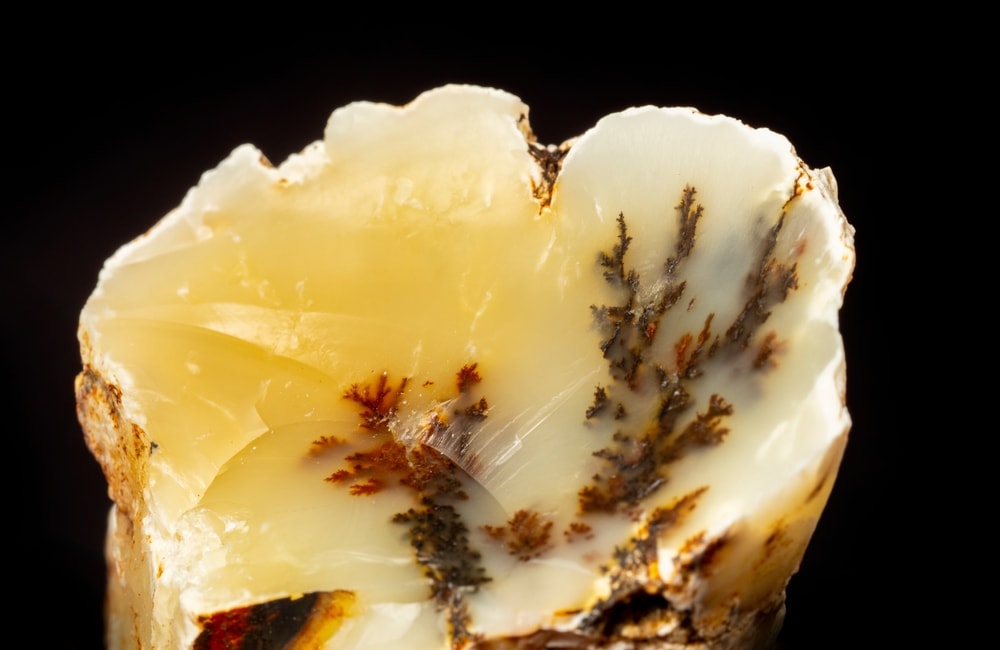
Dendritic opals are ordinary opals containing what look like “fossilized plants.” They are actually fern-like patterns caused by iron, manganese, and other oxides that have entered the opal. They’re also known as “Mossy Opals.”
The word dendritic means “branch-like.” It’s the name gemmologists use for these patterns in stones. It comes from the Greek “dendrites” meaning “tree-like.”
They are usually cut in slices to show off the delicate patterns caused by the oxides. These opals can be white, yellow, green, blue or pink.
You can find dendritic opals in America, Ethiopia, and Australia, but also spread across the world in Spain, Slovakia, Japan, Russia, Cuba, Austria and Guatemala.
8. Opalized Wood Opal
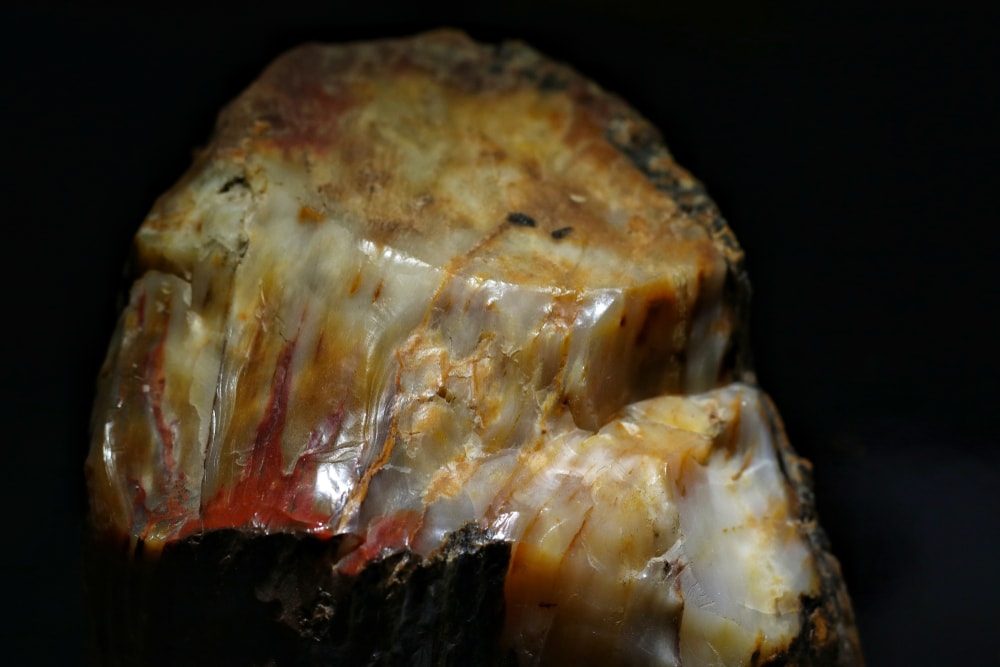
Opalized Wood opal is made of petrified wood!
Petrified wood happens most often when a forest is buried by volcanic ashfall. Silica from the ash seeps into the wood over time, together with water.
Most of the time, petrified wood is formed from chalcedony, but sometimes it is formed from opal.
To find out if the petrified wood is opal, you must test the specific gravity, the hardness, and the refractive index. These are all lower in opalized petrified wood.
It’s not normally worth very much as the opal tends to be ordinary rather than precious in petrified wood. If an especially beautiful piece is found with precious opal colors and made into jewelry, however, the value is massively increased.
This sort of gem is also exciting because it’s an organic gem – made from an animal or plant source!
9. Hyalite Opal

Hyalite opal is a lovely clear opal gemstone. It has a clear and bubbly texture and appearance. Hyalite means “glass-like.”
It bears a shocking feature, however. Firstly, hyalite glows green under ultraviolet light! This is due to the presence of radioactive uranium in the opal.
Before you run away shrieking, the amount of uranium in a hyalite opal is miniscule and not enough to harm anyone. It will set off a Geiger counter though, and fluoresces even in sunlight.
Hyalite opals can be found in Zacatecas, Mexico and the Zemplen Mountains of Hungary. They can also be found in the Northeastern US and Central Europe.
10. Matrix Opal
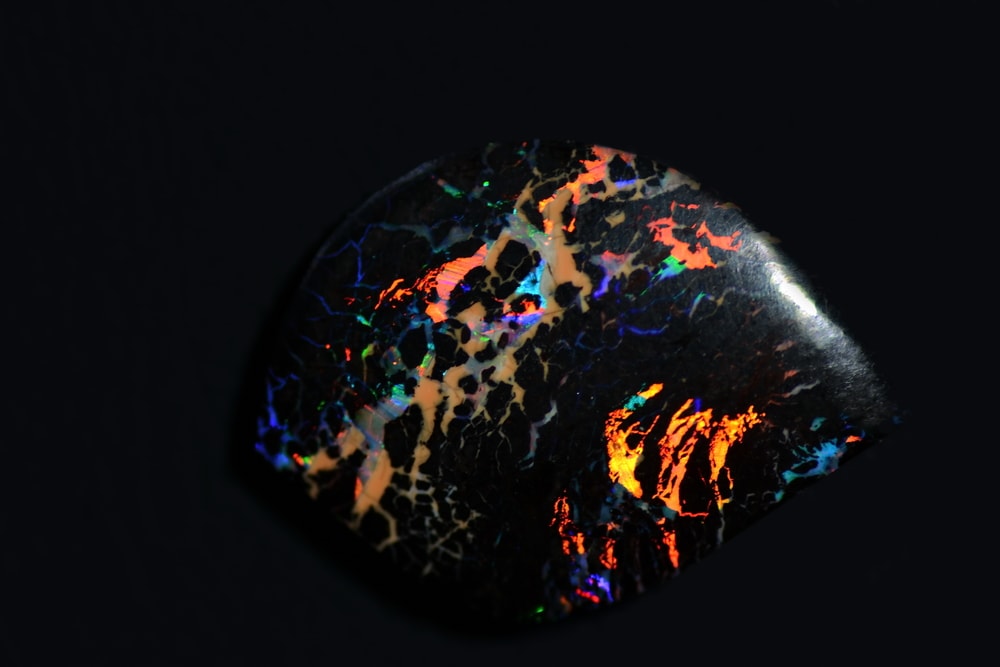
Matrix opal is a type of rock where precious opal is sprinkled throughout the whole bedrock in tiny pieces.
This means when a jewelry maker cuts a matrix opal, they must have an intimate knowledge of how the pieces of opal within will show up once it is cut. All without being able to see through the raw uncut rock!
Australian Andamooka Matrix Opals are some of the most sought after matrix opals. The host rock is porous and light colored, so the colors don’t show up.
Due to this, these stones are soaked in a sugar solution, then in sulphuric acid! This causes the stone to turn darker, becoming a lot more attractive to gem seekers.
11. Jelly Opal
Jelly Opals have a semi-translucent, watery look to them, with colors seeming to float about inside misty layers.
They look very like the “jelly sandals” of the 90s! They’re similar to crystal opals, but the play of color runs like water across the whole stone and there’s normally more color in a jelly opal.
A fine Mexican jelly opal sold for $27,500 at auction. It was actually a Mexican FIRE jelly opal. Mexican opals contain a large amount of iron oxide, so the predominant colors are red, orange, and pink. The Aztecs loved them!
You can also get them in Australia, the US, Brazil, and South Africa.
Crystal healers use jelly opal in folk magic to allow problems and illness to flow away like water.
12. Honey Opals
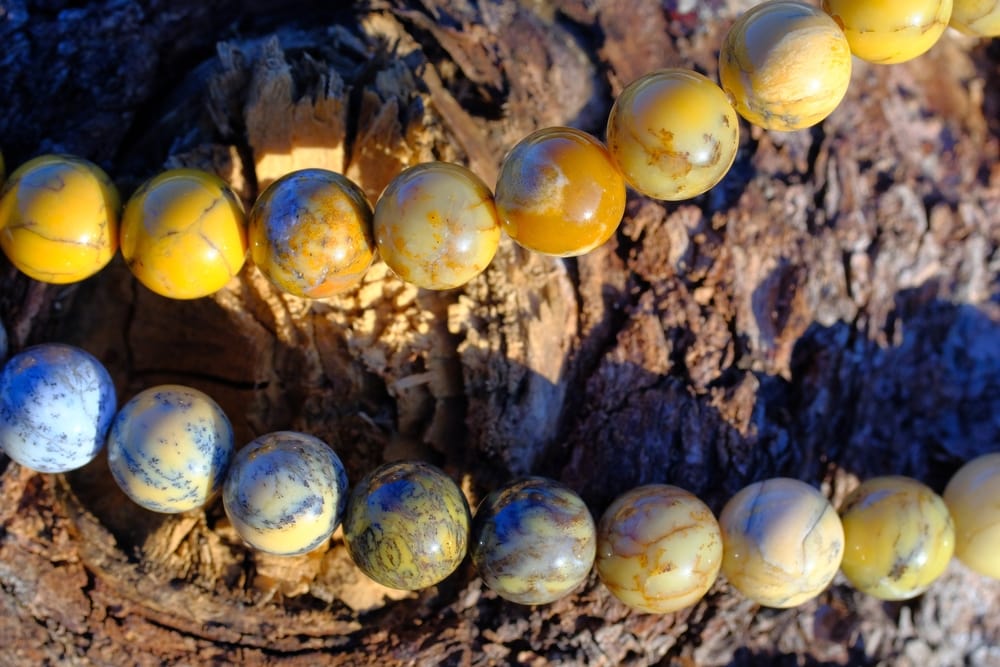
Honey Opal is a variety of ordinary opal which is golden yellow in color. That’s according to the scientists!
According to spiritual healers who use crystals, honey opal is associated with passion and adventure. It is linked with Aries and Sagittarius astrological signs. It can be used to forge new beginnings and opportunities.
Honey Opal with no play of fire can be bought fairly inexpensively. We’re talking $50 instead of $5000!
Don’t confuse honey opals with hydrophane (porous) opals that have turned yellow! This is due to the hydrophane soaking up chemicals or body oils.
13. Fairy Opals
Fairy opal is Australian sandstone containing tiny pieces of opal. It’s only found in Queensland. The pieces of opal are often blue.
Fairy opal is usually treated to darken the stone and make the colors stand out. It’s also treated to make it harder. This is done by cooking it in a sugar or honey solution until the mixture is carbonized! The fairy opal is cooked in either water or oil to achieve this.
The fairy opal is cut into its finished shape before the blackening process, as the blackening only goes a few millimeters deep and if the stone is reshaped, you would be able to see the lighter bits sticking out.
Despite all this processing, a nice piece of fairy opal is still worth quite a lot of money.
14. Hydrophane Opals
Hydrophane opals are very porous and absorb and lose water quickly. If you look at the structure of a hydrophane opal using a micrograph, you can see the sponge-like holes in the structure.
Many Ethiopian Opals are hydrophanes. They will absorb and lose water easily, and must be protected from long exposure to sunlight or heat. Hydrophane opals are also sometimes found in Indonesia, Virgin Valley in the US, and even in Boulder, Queensland, in Australia.
It’s amazing to watch a hydrophane opal absorb water. In about 30 minutes, the entire opal is full of water! The opal changes from opaque to translucent in the process.
It’s hard for a gemologist to measure the specific gravity of a hydrophane opal, as the opal becomes heavier due to its intake of water!
15. Mexican Fire Opal
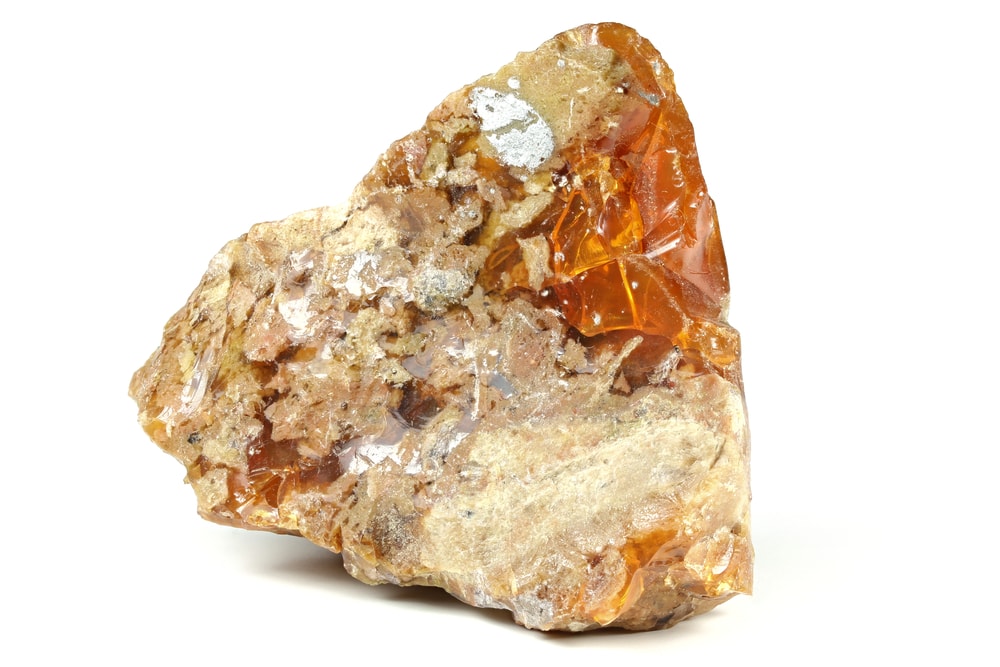
Mexican fire opal is the most well known fire opal. You can tell if a fire opal is from Mexico by checking the base rock. If it’s light pink in color, it’s rhyolite, which is common in Mexico. It sometimes has a play of color, but not always.
The ancient Mayan and Aztec people called fire opals “quetzalitzlipyollitli,” meaning “bird of paradise.”
These opals usually come from volcanic slopes in the Mexican highlands.
It’s still soft (6.5-7.5) on the MoHs hardness scale, so care must be taken not to chip or abrade it. The MoHs scale measures how hard a rock is, with 1 being the softest.
Here is a cut Mexican fire opal with a deep red fire. It has been cut into facets to show off its uniform color.
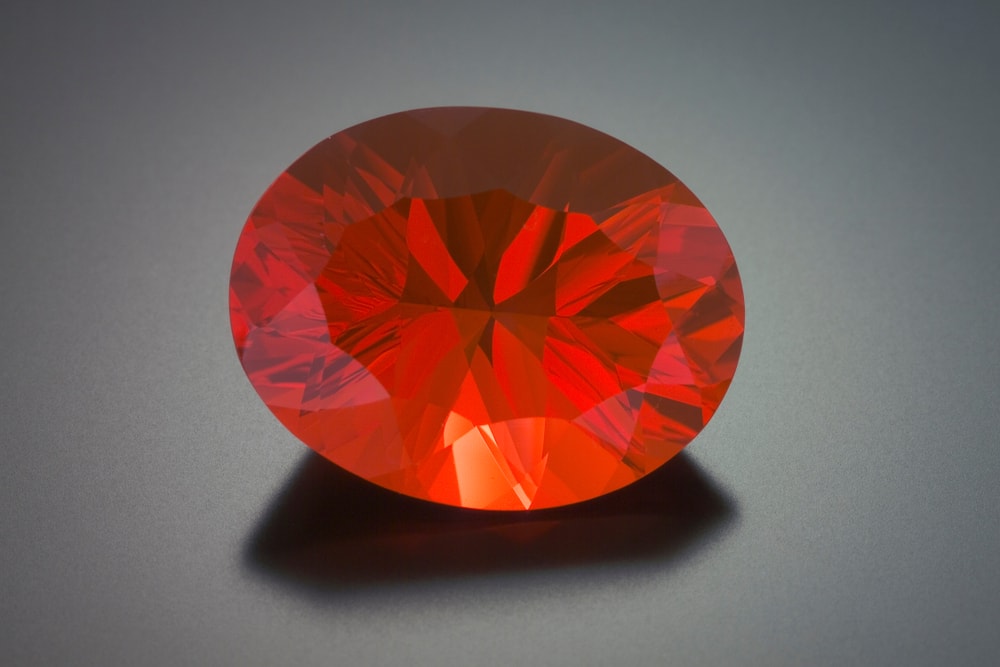
16. Australian Fire Opal
Australian fire opal has a base color of yellow or orange. It can have a lovely play of color. However, even fire opals without a play of color still look pretty.
Australian fire opal is often cut into facets or sharp angled cuts like other types of gems of only one color.
It’s known for its light base color. It’s not as absorbent as Ethiopian fire opal. It’s also not as translucent as either Mexican or Ethiopian fire opal.
Australian fire opals are mainly produced from a new opal field 600 km (372 miles) from Kalgoorlie.
Check out this video and watch how an Australian fire opal is made into an arrowhead!
17. Ethiopian Fire Opal
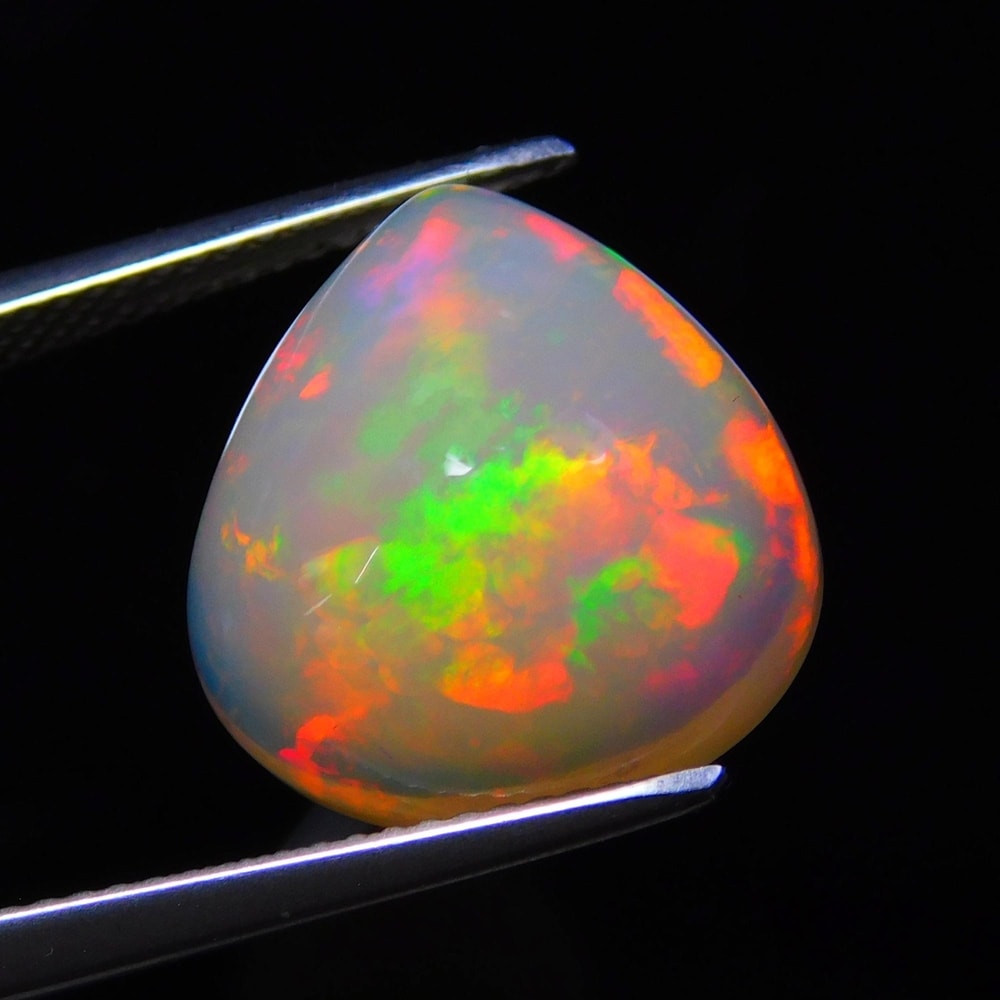
Ethiopian fire opal often has lots of play of color, usually with an orange body color.
It is more porous than Australian or Mexican fire opal. This means it absorbs water and other liquids such as skin oils. Most of it is from the Wollo province.
In 1994, there was a discovery of hot-colored opals in the Menz Gishe District, Shewa Province. The fire opals are in a bedrock of igneous rocks such as tuff, ignimbrite, and rhyolite.
They are liable to crazing, which is when the opal fractures internally. So gem cutters take great care to keep them in water before cutting them. As long as care is taken, these Ethiopian fire opals can be stunning.
Ethiopian fire opal is transparent, which means it looks good cut into facets, but the play of color means it also looks good as beads or in a cabochon (a smooth rounded polished stone).
18. Morado Opal
Morado opal is a purple and white ordinary opal found in Mexico. It’s also known as “Royal Opal.” Even though it has no play of color, it is still a fantastic looking stone. The word Morado comes from the Spanish word for “purple.”
It’s one of the cheapest opals that can be used to make jewelry. You can buy it in the rough raw state for about $100 per pound!
Morado opal is said to contain small amounts of fluorite, which makes it fluoresce under ultraviolet light.
19. Harlequin Opal
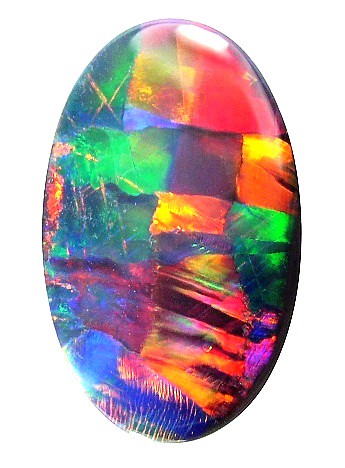
Harlequin opal has a repeating pattern of diamonds or squares in bright colors. To be a true Harlequin opal, the pattern must run across the entire stone.
Harlequin opal refers to a particular pattern seen on the opal rather than where it is from or what it is made of.
The harlequin pattern is very rare and so very desirable to collectors. Many miners and collectors will go their whole working life without finding one.
This pattern is similar to the one worn by French opera players in “commedia dell’arte.” Their costume would be a pattern of bright diamonds all over their body.
Australian Harlequin opals can be worth from $5k-$30k per carat!
20. Tanzanian Green Opal
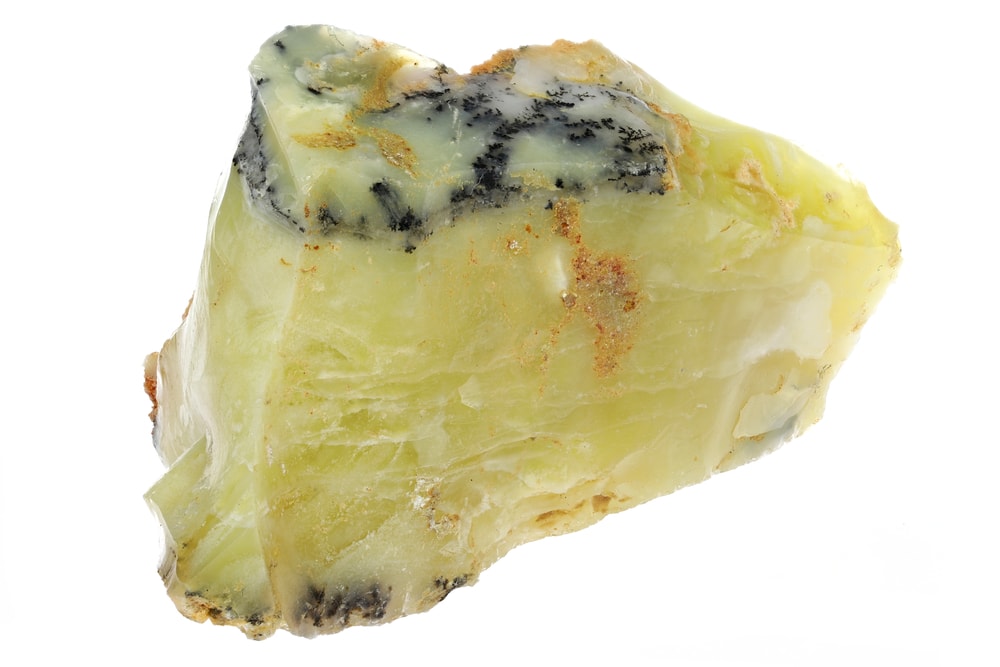
In Tanzania, Africa, there are two types of opal. One is a deep blue-green and is known as Green Opal or Prase Opal. It is mined from the slopes of Mt Iyumbo. It’s also known as “African Jade” due to its resemblance to jade stone.
It contains a lot of nickel. In prehistoric times, African people used it to make tools. It’s also reputed to be good for your eyes!
21. Madagascan Pistachio Opal
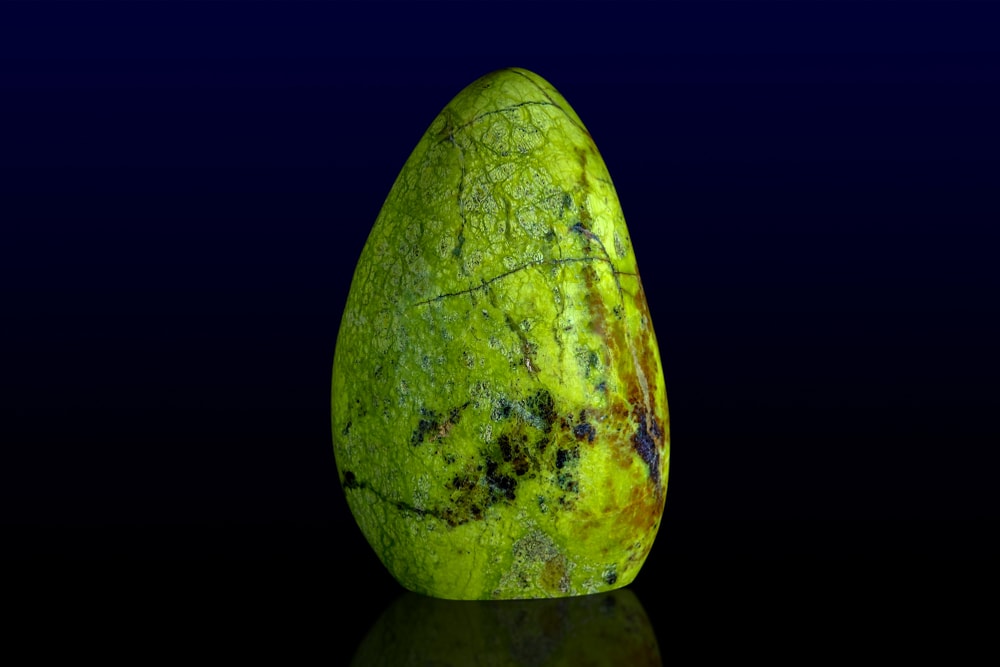
Opal mined off the coast of south Africa, in Madagascar, can be a vibrant green color. As the name suggests, it looks like pistachios! It’s also known as “Kiwi Opal.”
This ordinary opal is mined near Antananarivo, Madagascar’s capital city. It can be bought very cheaply.
Spiritually, it is believed to be able to ward off intense stress from social situations such as meetings. It is also said to aid confidence and self esteem.
22. Peruvian Opal
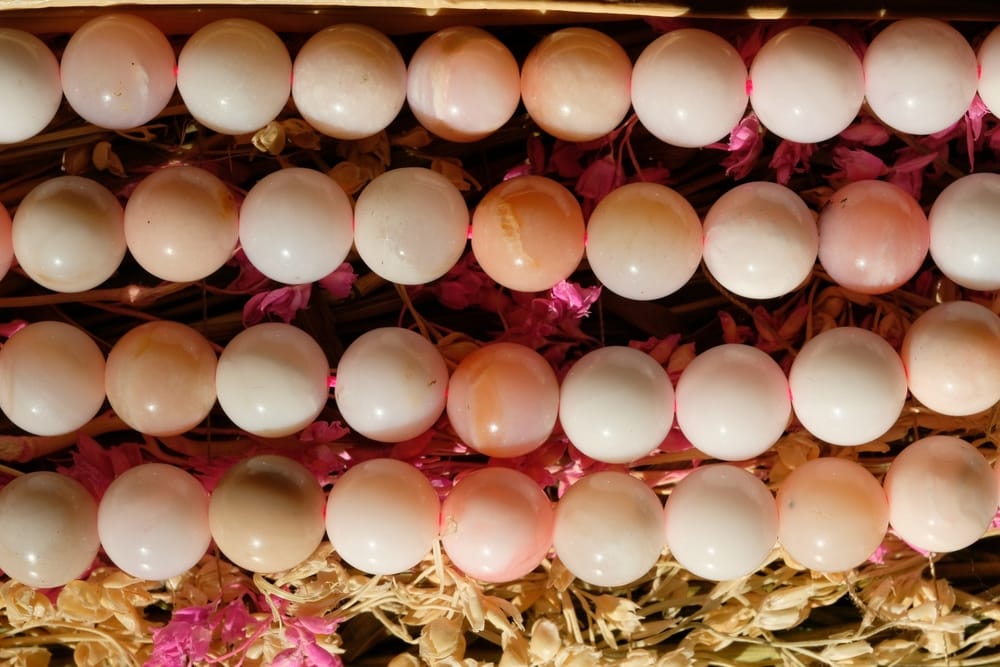
Peruvian opal can either be pastel pink or pastel blue. It’s technically an ordinary opal, as it has no play of color. However, it’s a beautiful stone nonetheless.
They are often used for cheaper jewelry and beads for necklaces.
Peruvian Opal is quite rare and only found in the Andes. It is supposedly good for relaxing tension and helping people sleep.
23. Slovakian Opal
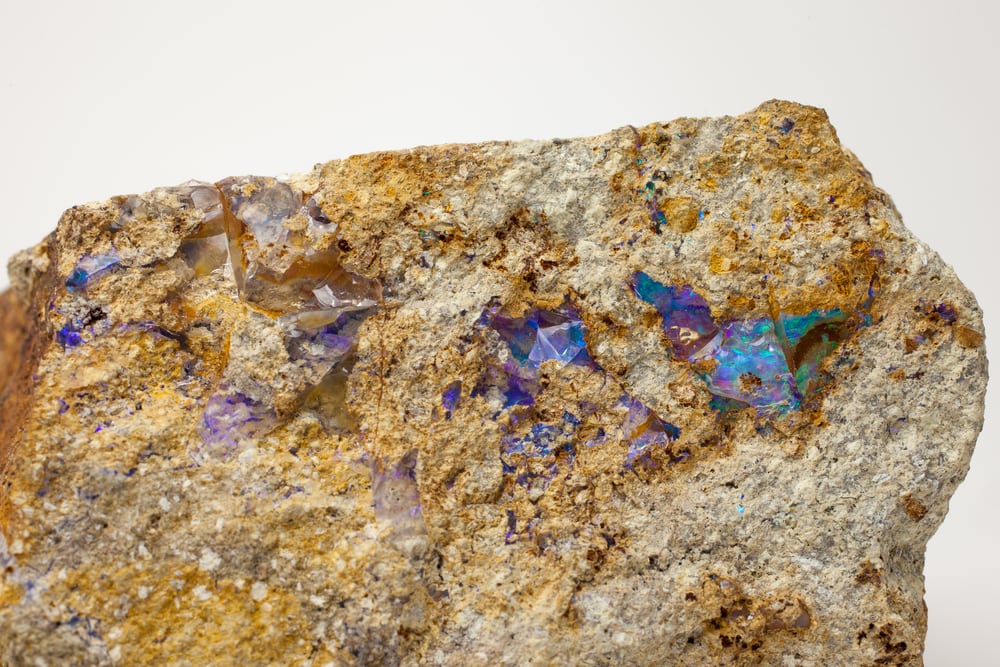
Slovakian opal can be recognized by its light and clear base color. It has a play of color with flashes of blue and orange.
The Slovakian opal industry had its heyday between 1845-1880, before Australian opals were discovered. Before this, they controlled the majority of the market for white opals.
There are some that believe the famous “Trojan Fire” or “Burning of Troy” opal has its origins here and not in Honduras.
If you visit the Natural History Museum in Vienna, you can see the Harlequin opal, which is protected in a shielded box.
24. Indonesian Opal
Indonesian opal is mined from only 7 mines deep in the wilderness in Indonesia. It is famous for its jet black base color. Indonesian farmers often mine opal as a lucrative side business.
You can tell it apart from other types of black opal by its semi translucent potch, which is the piece of base rock it is attached to.
25. Bacon Strip Opal
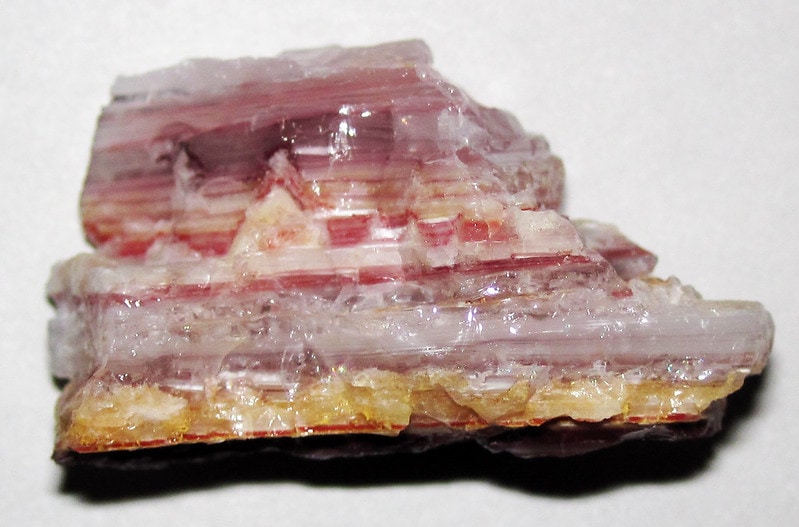
The fantastically named Bacon Strip Opal is an ordinary opal. However, it is fantastic to look at as it really does look like bacon!
It is found only in Utah, US. The stripes in this opal are pink, yellow, white and red. It’s also called Candy Strip after candy canes.
The layers of bacon opal are delicate and hard, but not impossible to cut into jewelry. It gets its colors from minerals such as hematite.
You May Also Like: How Are Metamorphic Rocks Formed? (Full Explanation)
Eric the Pliosaur – The Weirdest Opal!
The strangest opal has to be the opalized fossil of Eric, a Pliosaur. These swimming reptiles date from the time of the dinosaurs. They had a dolphin-like body with a crocodile’s head and four flippers.
In 1987, an opal miner working in Coober Pedy, Australia, unearthed a complete Pliosaur skeleton fossil covered in opal. The semi-precious opal had sunk into the dinosaur’s bones as the fossil formed during the Jurassic period.
After trying his best to extract most of the 7ft (2.13m) fossil himself, the excited miner damaged and lost some of the fossil’s bones.
Despite this, he sold it to a businessman, Sid Londonish, for AUD 125k, which is about $85k today. The opal within the skeleton is worth about AUD 25,000 ($17k), but the fossil is worth a lot more.
A fossil expert named Pail Willis named the fossil Pliosaur “Eric” after a Monty Python sketch! He called the opalized fish bone he found in Eric’s stomach “Wanda.” This just goes to show that paleontologists really do have a sense of humor…
After Mr Londonish experienced financial difficulties, many jewelers wanted to break up the fossil and sell it as jewelry. Luckily, the Australian Museum in Sydney bought the bones at the last minute to preserve them for all to enjoy.
More Noteworthy Opals
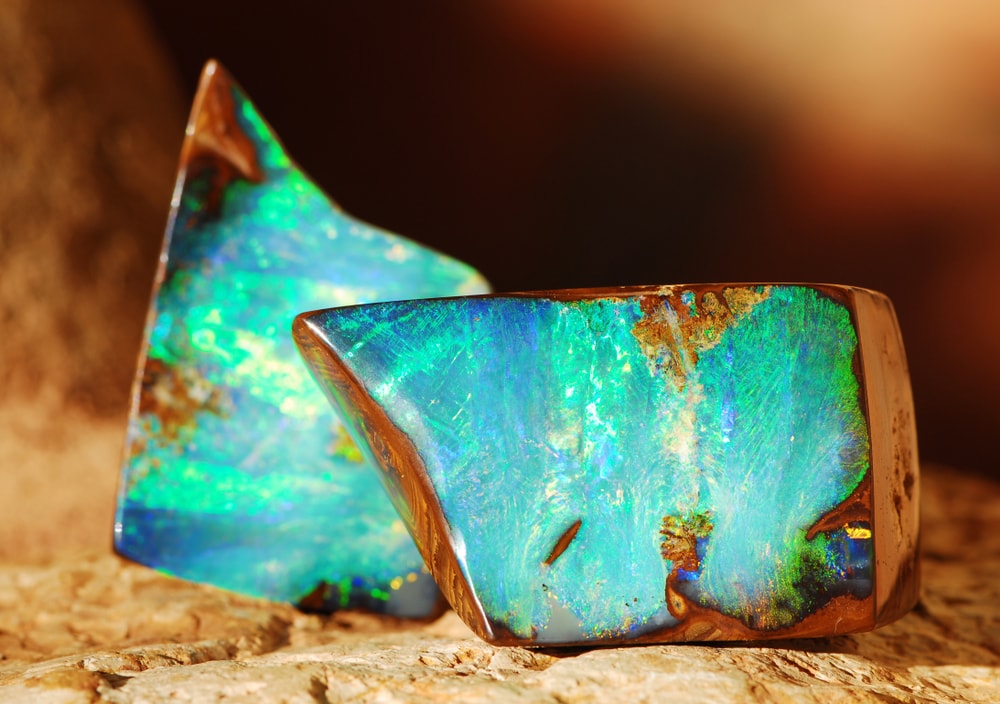
There are some stunning opals with stories to tell from around the world. They all have names! Here are just a few of the best.
The Queen’s Opal: Also called the Andamooka Opal, this 200 carat off-white opal adorned the head of the English Queen Elizabeth II on state occasions. It is set in a palladium tiara to be worn on the head. It is from Australia.
The Virgin Rainbow: This 11-inch (28cm) long precious black opal is not only stunning, but it also has a superpower. It glows in the dark!
It is worth over AUD 1M as it is the longest piece of precious opal in the world. It is actually a fossil Belemnite, a type of extinct sea creature!
The Flame Queen: The Flame Queen was discovered in 1918 by three prospecting miners in an old dry opal mine, this structured gem was discovered when one of the miners grabbed at a “nobby” on the side of a vertical shaft as they were heading home!
The gem has a deep red heart and a blue-green border. It was carefully cut to preserve its natural beauty.
The miners sold it quickly for $98. In 2003, it was sold for an estimated $250,000!
Aurorae Australis: The Aurorae Australis is officially the world’s most expensive opal. It is only 3×2 inches (8×5 cm) large and cut like a hair barrette.
This black opal was valued at AUD 1M in 2003, which is roughly $700k right now. It’s known for a its fantastic play of color. It also has a shape like a starfish in the bedrock at the back.
The Burning Of Troy: This 700 carat gem was presented to the Empress Josephine by Napoleon.
It was mined either in Honduras or in Slovakia around 1918. It was then lost! It was so named due to the fiery reds and oranges within it. It didn’t take much to imagine the burning and sack of a great walled ancient city.
You May Also Like: Types Of Landforms: From The Top Of The Globe To The Depths Of The Sea
Types of Opals FAQs
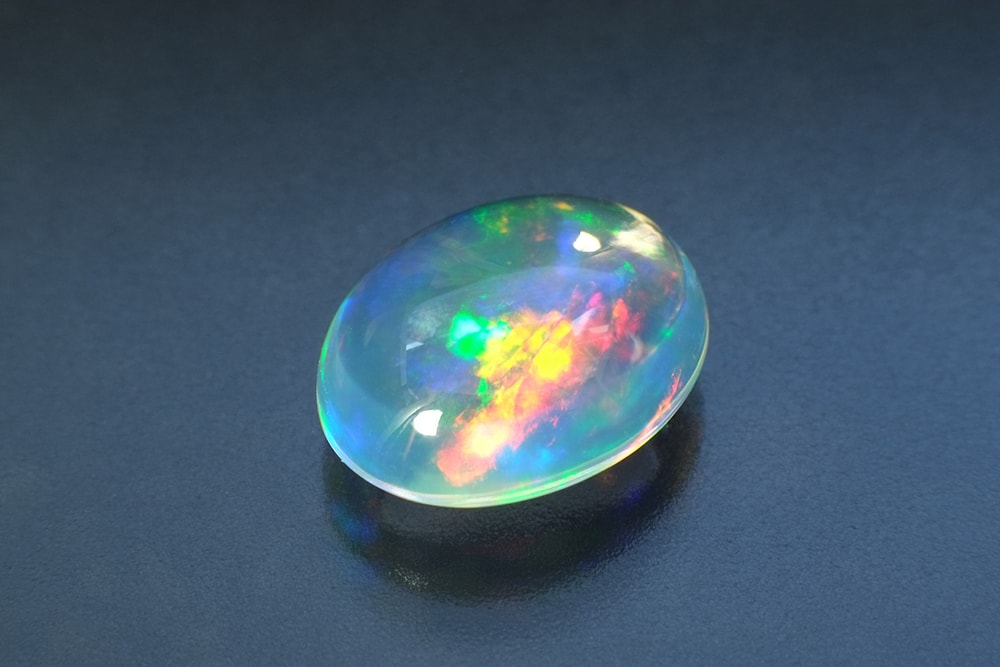
How long does it take for an opal to form?
Opals were formed on earth during the Cretaceous period, when dinosaurs roamed the landscape. They were pushed toward the surface in the Pleistocene age. So, they were formed over 65 million years ago!
How many varieties of opals are there?
There are 4 main types and 25 varieties of opals worldwide.
What affects the price of an opal?
Play of color and base color is very important in determining an opal’s price. What is happening politically and economically in its country of origin plays a big part, too.
How well the opal mine is doing with their production rate also affects the price. Lastly, it can depend on the personal preference of the person buying it!
Does water damage opals?
No, water does not damage opals. A hydrophane opal may absorb some of the water, but this won’t damage it.
Opals that are non absorbent, such as Australian opals, will not absorb the water. Opals are partly composed of water, but this is locked in a stable structure.
Does sunlight damage opals?
Sunlight can damage opals, especially if they are hydrophane opals such as those from Ethiopia. It’s not the sunlight that affects them though – it’s the heat.
Prolonged exposure to heat causes hydrophane opals to dry out. They are then prone to cracking.








